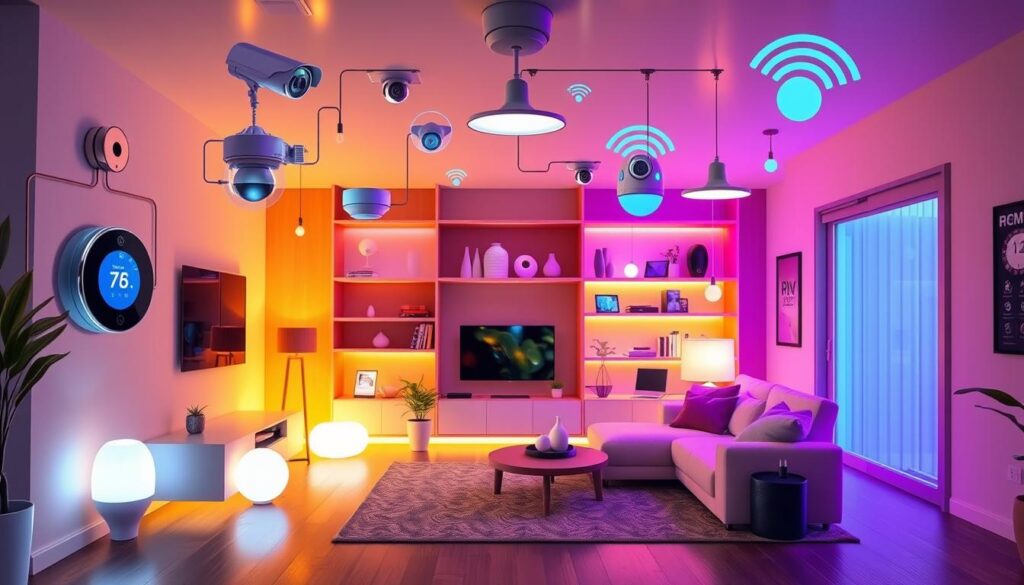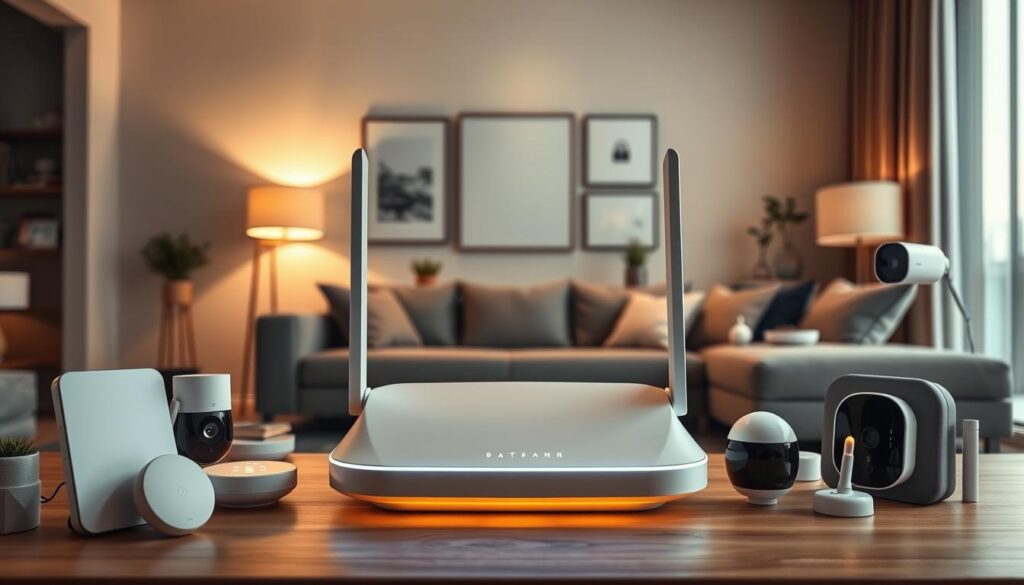Smart home robots and automation face a big hurdle: the tech gap in smart homes. Many different ways to connect devices make it hard for people to pick the right ones. To fix this, experts suggest two solutions: a single protocol for all devices or a central controller that works with many.
But, making every device work together is a huge challenge. Gateway makers struggle to support all devices, limiting what consumers can choose. This makes it hard for smart home robots and robotics to become common in homes soon.
Introduction to Compatibility Issues in Smart Homes
The smart home world has grown fast, thanks to new smart home technology and the Internet of Things (IoT). But, a big problem is the lack of standard in the smart home ecosystem. This makes it hard for connected home devices to work together well.
Technological Fragmentation Within the Smart Home Ecosystem
Choosing devices for your home automation is tricky because of different home connectivity protocols. You might find ZigBee, Z-Wave, Wi-Fi, and Bluetooth in your home. This mess makes it hard for people to pick devices that work together smoothly.
The industry is trying to fix this with a new standard called Matter. Big names like Google, Amazon, Apple, and IKEA support it. Matter wants to make sure all smart home platforms like HomeKit, Google Home, and Alexa work together well. It uses Thread, Wi-Fi, and Ethernet for local control, keeping your home safe and private.
As the smart home ecosystem grows, using global standards is key. It will help solve the problem of devices not working together. This will make home automation more popular and accepted by everyone.

The Role of Smart Home Gateways in Addressing Compatibility
The smart home world is growing fast, but it faces a big problem: getting different devices to work together. To solve this, experts suggest using smart home gateways. These gateways can handle many protocols and control all your smart devices. This idea is getting more attention as more smart products come out.
But, making all devices work with each other is hard for makers. It’s tough to support every device, so gateways list which ones they work with. Even with a long list, some devices still don’t work, making it hard to control everything easily.
The Rise of Modular and Multiprotocol Smart Home Gateways
New smart home gateways are being made to tackle these issues. They can connect with many devices and use different ways to talk to them, like Zigbee, BLE Mesh, and Wi-Fi. These gateways can also grow and change as new tech comes out, making them future-proof.
Also, using open-source platforms like Home Assistant and OpenHAB in these gateways makes things easier. These platforms help manage many devices from one place, making smart homes simpler to use and more appealing.
| Protocol | Adoption in Smart Homes |
|---|---|
| Zigbee | The predominant communication protocol in the smart home sector due to its low power consumption and robust networking capabilities. |
| BLE Mesh | Increased adoption in smart home lighting, particularly in Bluetooth mesh lighting control applications, due to its exceptional networking performance and convenience. |
| Wi-Fi | Widely used for connecting smart home devices that require higher data rates and internet connectivity, such as smart displays and streaming devices. |
Smart home gateways are key in solving the problem of getting devices to work together. They make it easy to connect and control a wide variety of smart devices in your home.

Home Robot Development: Proposed Gateway Architecture
As the need for robotic home assistants grows, engineers are looking for new ways to solve old problems. They want to make the smart home system work better together. This paper suggests a new software design for smart home gateways to fix these issues.
The new gateway design can handle many different protocols at once. This means it can control various devices in a home, no matter their type. It uses a virtual device for each real device and standard APIs for talking to them.
To make sure the gateway works with new devices, it has a special module. This module updates the device profile, which tells the gateway how to control the device. This way, the gateway can work with new devices without changing the protocol or the device itself.
The proposed gateway architecture aims to solve the problem of different systems not working together. It creates a single control system for all home robot development and robotic home assistant technologies. It makes it easier to manage updates and connect different networks, leading to a better smart home experience.
Advantages of the Proposed Gateway Architecture
The new smart home gateway architecture has many benefits. It solves the problem of different devices not working together. Homeowners can control all their smart devices with one easy-to-use interface.
Unified Control Over Heterogeneous Networks
This gateway makes it easy to use all sorts of smart devices together. It simplifies managing a smart home. Homeowners can easily control their devices, no matter the brand or how they communicate.
Support for Future Devices Through Dynamic Updates
This gateway is made to keep up with new technology. It can update itself to work with new devices. This means homeowners can always have the latest smart home features without having to replace their system.
| Key Advantage | Description |
|---|---|
| Unified Control | The gateway enables seamless control over a diverse range of smart home devices, simplifying the user experience. |
| Heterogeneous Network Integration | The gateway integrates and manages devices across various communication protocols and brands, ensuring compatibility. |
| Dynamic Device Profile Updates | The gateway’s ability to dynamically update device profiles allows it to support the latest smart home technologies. |
| Future-proof System | The gateway’s adaptability ensures the smart home system remains compatible and relevant as the ecosystem evolves. |
This gateway architecture solves the problem of different devices not working together. It lets homeowners enjoy a smart home that keeps up with their needs and the latest technology.
Conclusion
Smart home technology has seen slow growth due to compatibility issues. These problems come from different connectivity protocols in the smart home world. Researchers suggest using smart home gateways to solve this. These gateways can handle many protocols and act as a central control for all smart devices.
The gateway architecture is seen as a good solution. It offers unified control over different networks and can update to support new devices. This way, smart homes can stay compatible with future technology.
The need for easy integration and working together in smart homes is growing. Improving gateway architectures and developing home robots are key. By fixing compatibility issues, homeowners can enjoy a fully integrated and efficient smart home.

